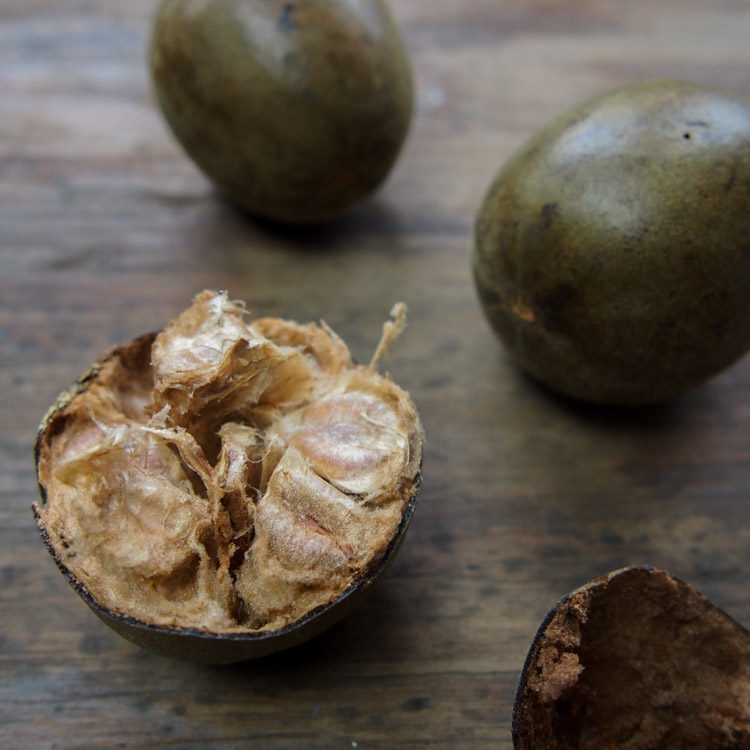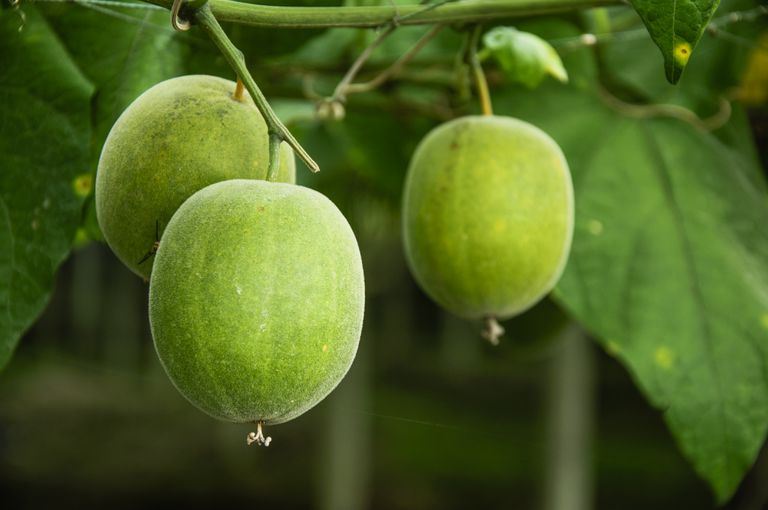Monk fruit is all the rage lately, thanks to the never-ending search for an alternative sweetener to sugar that’s not made from artificial sweeteners such as sucralose, aspartame and saccharin. One such natural sweetener is stevia, which I discussed in my last blog. More recently, we've seen sweeteners derived from monk fruit. What fruit, you say?

Indigenous to China and Thailand, monk fruit (a green, round melon-looking fruit) is grown on a vine known as Siraitia Grosvenorii, named for the president of the National Geographic Society in the 1930s who funded an expedition to find the fruit. In Chinese, it is called luo han guo. It has zero calories and is said to be up to 500 times sweeter than sugar.
Monk Fruit is a member of the gourd family and a distant cousin of the cucumber and melon. It's colloquially referred to as monk fruit because it was said to have first been used by monks in China in the 13th century. The first report in England on the herb was found in an unpublished manuscript written in 1938 by G. Weidman Groff and Hoh Hin Cheung. The report stated the fruits were often used as the main ingredients of "cooling drinks" as remedies for hot weather, fever, or other dysfunctions traditionally associated with warmth or heat.
When eaten fresh, monk fruit does offer 25 percent to 38 percent various carbohydrates, as well as vitamin C. However, monk fruit doesn’t keep very well after harvest and is difficult to store and transport without fermenting. Most often, it is dried until dark brown in colour, and then steeped as a tea to treat symptoms of congestion, inflammation, coughing and sore throat.
Today, it is still used for its medicinal properties and is also believed to promote a long life, earning it the nickname, “The Longevity Fruit” thanks to its high antioxidant levels.
Unlike most fruits, whose sweetness comes from fructose sugar, Monk Fruit’s sweet taste comes from a different kind of substances called mogroside, which tastes extremely sweet but has negligible calories.
While monk fruit itself has been treating illness in China for thousands of years, the processed commercial version is relatively new to the market. That's because, though sweet, monk fruit has some interfering flavours, nullifying the actual fruit's ability to be used as a sweetener. Commercial monk fruit extracts are continuously being improved to eliminate the interfering tastes and make a useful sweetener from the fruit. Overall, the response to monk fruit sweetener has been positive, though some say that it leaves you with a less than pleasing aftertaste (though less bitter than the aftertaste a lot of people complain about with stevia).
Why is Monk Fruit so sweet?
Monk fruit is not only sweet due to natural sugars like most fruits. It contains mogrosides, a group of triterpene glycosides (saponins), which are metabolised differently by the body than natural sugars. The fruit contains 25 to 38% of various carbohydrates, mainly fructose and glucose. The sweetness of the fruit is increased by the mogrosides. That’s why, despite their very sweet taste, these fruits contain no calories and have no effect on blood sugar.
Mogrosides, consist of a backbone structure called a mogrol with glucose units or glycosides attached to it. The five different mogrosides are numbered from I to V; the main component is mogroside V, which is also known as esgoside.
Most of what is known about mogroside metabolism comes from studies done on animals, which is thought to be the same or similar to mogroside metabolism in humans. Mogrosides are not absorbed in the upper gastrointestinal tract and do not contribute to any calories to our diet. When they reach the colon, gut microbes cleave off the glucose molecules and use them as an energy source. The mogrol and some metabolites are then primarily excreted from the gastrointestinal tract, while minor amounts are absorbed into the bloodstream and excreted in the urine.

Monk Fruit Benefits
Fights Free Radicals
Monk fruit’s mogrosides, the compounds that give it its intense sweetness, are also powerful antioxidants. Oxidative stress plays a part in many diseases and disorders, and choosing high-antioxidant foods is the key to reducing free radical damage in the body. Studies have shown that mogrosides “significantly inhibited reactive oxygen species and DNA oxidative damage”.
Acts as an Anti-Inflammatory and Coolant
Ancient Chinese usage of this fruit included drinking tea made from the boiled fruit to cool the body from external and internal sources and ailments from fever to heat stroke. It was also used to soothe a sore throat. This method worked because of monk fruit’s anti-inflammatory abilities. Many studies prove its anti-inflammatory powers are most likely the reason it’s able to positively affect so many other diseases and disorders.
Combats Cancer
Many studies have proven the anti-carcinogenic effects of the natural sweeteners contained in monk fruit. Some studies have shown its abilities in inhibiting skin and breast tumour growth as well as providing proteins that have potent anticancer abilities. However, more studies into its cancer combating properties are needed to substantiate these findings and more.
Treats Bacterial Infections
Monk fruit has shown great results in inhibiting the growth of bacteria, specifically oral bacteria that cause tooth decay and periodontal disease. These studies have also shown the fruit’s ability to fight some forms of candida symptoms and overgrowth, like oral thrush, which when left untreated can affect many other body systems.
Fatigue Fighter
In a study on mice, monk fruit extracts were successful in decreasing fatigue in exercising mice. The study was able to reproduce the results and prove that mice given the extract had extended exercise times. This study may give evidence as to why monk fruit has long been referred to as the “longevity fruit.”
Naturally Controls Diabetes
This fruit was used as an anti-diabetic by the Chinese for centuries. Aside from being a proven anti-hyperglycaemic (which helps bring down the blood glucose levels in the body), studies have also shown targeted antioxidant abilities toward pancreatic cells, allowing better insulin secretion in the body. Thus, monk fruit works well as a natural diabetes treatment.
The anti-diabetic abilities of the monk fruit are associated with its high levels of mogrosides. Better insulin secretion is a major part of improving diabetic patients’ health, and monk fruit has even shown results in reducing kidney damage and other diabetes-related issues. As a sweetener with a low glycaemic index, it’s also a way for those struggling with diabetes to be able to enjoy a sweet flavour without the concern of affecting or worsening their diabetic condition.
Natural Antihistamine
Monk fruit extract, when used repeatedly, has shown an ability to fight allergic reactions as well. In a study with mice, monk fruit was administered repeatedly to mice exhibiting nasal rubbing and scratching due to histamines. The study showed that “both the [lo han kuo] extract and glycoside inhibited the histamine release” in the test subjects.
Recipes for Health
There are a few ways you can get the benefits of monk fruit into your home. Due to its short shelf life, the only way to try it fresh would be to travel to Southeast Asia and buy one fresh off the vine! The next best way to get the rewards of this natural sweetener is by purchasing monk fruit extract or monk fruit sweetener. Monk fruit extract is manufactured in a number of different ways. Most commonly, the fresh fruit is harvested and the juice is combined with a hot water infusion, filtered and then dried to create a powdered extract. The sweetness is contained in the mogrosides, and depending on the manufacturer, the percentage of the compound varies. Beware of added ingredients like molasses and a sugar alcohol called erythritol, which will decrease the health benefits of the product.
You can use monk fruit sweeteners to sweeten almost anything, including:
· Coffee
· Hot tea, iced tea, or lemonade
· Salad dressings
· Sauces
· Smoothies
· Frostings
· Yogurt
· Oatmeal or other hot cereals
There are products and recipes for using this sweetener in baked goods which you can find online. I haven’t mentioned any as I haven’t found any product in the UK which is cost effective for, say, baking a cake. Most recipes use products with erythritol and ask for the same quantity as you would need for substituting the sugar ingredient. This amount is huge considering the price for monk fruit sweetener at the moment is around 30 times more expensive than your normal bag of sugar.
Dried monk fruit can be found at many Chinese markets and is simply a dried version of the fruit. You can use the dried fruit in soups and teas. One half to 2 pieces (approximately 9 to 15 g) of the dried fruit is commonly used as a tea after simmering in boiling water.
Precautions
Monk fruit is a member of the Curcurbitaceae family (also known as the gourd family), which includes pumpkin, squash, cucumbers, and melons. Your risk of monk fruit allergy is higher if you’re allergic to other gourds. Signs of allergic reaction may include:
· hives or rash
· difficulty breathing
· rapid or weak pulse
· dizziness
· swollen tongue
· stomach pain or vomiting
· wheezing
Apart from this, there are no reported monk fruit side effects or negative reactions, which means it’s safe for adults, children and pregnant/nursing women. It was approved by the FDA in 2010 as generally safe for consumption, which is relatively recent. There are no long-term studies available to test monk fruit side effects over time, so it’s always best to exercise care when consuming.
To Sum Up…
This round and greenish fruit with a brittle shell originated in a very specific climate found in Northern Thailand and Southern China. Known for its healing benefits for centuries, it was not popularly used in Traditional Chinese Medicine because it was so rare, difficult to cultivate and usually grown in family-sized orchards. The raw fruit has a sweet, refreshing taste and a distinct “cooling” property that leads it to be used against inflammation. When dried, it is also used to steep in tea to treat inflammation and congestion.
While most fruits get their sweetness from fructose sugar, Monk Fruit’s sweet taste comes from a different kind of substances called mogroside. This powerful antioxidant metabolises differently to natural sugars, tastes extremely sweet but has negligible calories.
With the need to find natural sweeteners, manufacturers have developed monk fruits sweeteners in powder form for people with diabetes who want the sweetness without it compromising their health. Small randomised trials have shown that monk fruit sweeteners do not negatively impact blood sugar or insulin levels. Other benefits demonstrated have been its ability to fight cancer, bacterial infections, fatigue, free radicals and allergic reactions. It could possibly help those wanting to lose weight by substituting dietary sugar with monk fruit sweetener in their teas, coffees, smoothies, yoghurts, cereals etc.
Since monk fruit sweeteners are relatively new to the food supply, their impact on, and association with, chronic conditions like obesity and diabetes has not been well studied. However, they have been safely used for centuries in Asian cultures and have not demonstrated any side effects, even after very high amounts have been consumed. More research is definitely needed to explore their full potential so watch this space. Still, it seems to be a good choice for those with diabetes and anyone who wants to limit dietary sugar.
Sources
https://www.lakanto.com/blogs/news/the-legend-behind-the-monk-fruit-name
https://en.wikipedia.org/wiki/Siraitia_grosvenorii
https://www.mnn.com/food/healthy-eating/stories/what-is-monk-fruit
https://foodinsight.org/everything-you-need-to-know-about-monk-fruit-sweeteners/
https://draxe.com/nutrition/fruit/monk-fruit/
https://www.healthline.com/health/food-nutrition/monk-fruit-health-benefits#allergies
